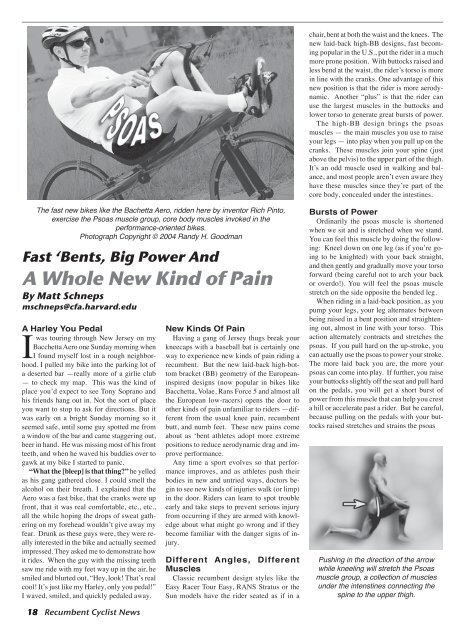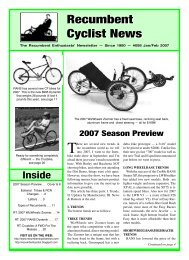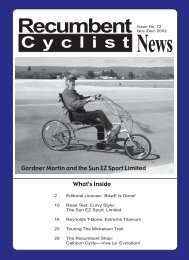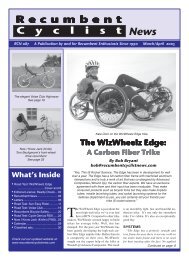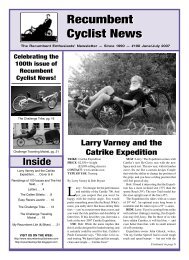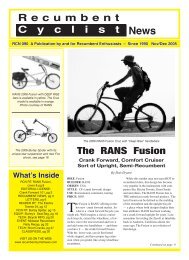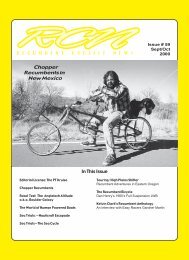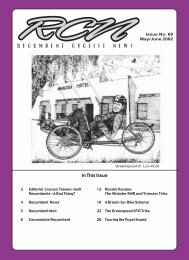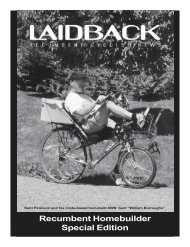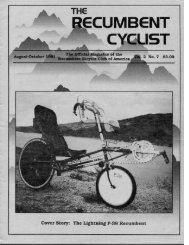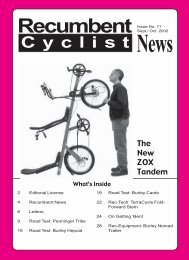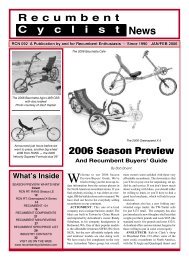C y c l i s t Recumbent - Steve Briggs
C y c l i s t Recumbent - Steve Briggs
C y c l i s t Recumbent - Steve Briggs
You also want an ePaper? Increase the reach of your titles
YUMPU automatically turns print PDFs into web optimized ePapers that Google loves.
chair, bent at both the waist and the knees. The<br />
new laid-back high-BB designs, fast becoming<br />
popular in the U.S., put the rider in a much<br />
more prone position. With buttocks raised and<br />
less bend at the waist, the rider’s torso is more<br />
in line with the cranks. One advantage of this<br />
new position is that the rider is more aerodynamic.<br />
Another “plus” is that the rider can<br />
use the largest muscles in the buttocks and<br />
lower torso to generate great bursts of power.<br />
The high-BB design brings the psoas<br />
muscles — the main muscles you use to raise<br />
your legs — into play when you pull up on the<br />
cranks. These muscles join your spine (just<br />
above the pelvis) to the upper part of the thigh.<br />
It’s an odd muscle used in walking and balance,<br />
and most people aren’t even aware they<br />
have these muscles since they’re part of the<br />
core body, concealed under the intestines.<br />
The fast new bikes like the Bachetta Aero, ridden here by inventor Rich Pinto,<br />
exercise the Psoas muscle group, core body muscles invoked in the<br />
performance-oriented bikes.<br />
Photograph Copyright © 2004 Randy H. Goodman<br />
Fast ‘Bents, Big Power And<br />
A Whole New Kind of Pain<br />
By Matt Schneps<br />
mschneps@cfa.harvard.edu<br />
A Harley You Pedal<br />
Iwas touring through New Jersey on my<br />
Bacchetta Aero one Sunday morning when<br />
I found myself lost in a rough neighborhood.<br />
I pulled my bike into the parking lot of<br />
a deserted bar —really more of a girlie club<br />
— to check my map. This was the kind of<br />
place you’d expect to see Tony Soprano and<br />
his friends hang out in. Not the sort of place<br />
you want to stop to ask for directions. But it<br />
was early on a bright Sunday morning so it<br />
seemed safe, until some guy spotted me from<br />
a window of the bar and came staggering out,<br />
beer in hand. He was missing most of his front<br />
teeth, and when he waved his buddies over to<br />
gawk at my bike I started to panic.<br />
“What the [bleep] is that thing?” he yelled<br />
as his gang gathered close. I could smell the<br />
alcohol on their breath. I explained that the<br />
Aero was a fast bike, that the cranks were up<br />
front, that it was real comfortable, etc., etc.,<br />
all the while hoping the drops of sweat gathering<br />
on my forehead wouldn’t give away my<br />
fear. Drunk as these guys were, they were really<br />
interested in the bike and actually seemed<br />
impressed. They asked me to demonstrate how<br />
it rides. When the guy with the missing teeth<br />
saw me ride with my feet way up in the air, he<br />
smiled and blurted out, “Hey, look! That’s real<br />
cool! It’s just like my Harley, only you pedal!”<br />
I waved, smiled, and quickly pedaled away.<br />
New Kinds Of Pain<br />
Having a gang of Jersey thugs break your<br />
kneecaps with a baseball bat is certainly one<br />
way to experience new kinds of pain riding a<br />
recumbent. But the new laid-back high-bottom<br />
bracket (BB) geometry of the Europeaninspired<br />
designs (now popular in bikes like<br />
Bacchetta, Volae, Rans Force 5 and almost all<br />
the European low-racers) opens the door to<br />
other kinds of pain unfamiliar to riders —different<br />
from the usual knee pain, recumbent<br />
butt, and numb feet. These new pains come<br />
about as ‘bent athletes adopt more extreme<br />
positions to reduce aerodynamic drag and improve<br />
performance.<br />
Any time a sport evolves so that performance<br />
improves, and as athletes push their<br />
bodies in new and untried ways, doctors begin<br />
to see new kinds of injuries walk (or limp)<br />
in the door. Riders can learn to spot trouble<br />
early and take steps to prevent serious injury<br />
from occurring if they are armed with knowledge<br />
about what might go wrong and if they<br />
become familiar with the danger signs of injury.<br />
Different Angles, Different<br />
Muscles<br />
Classic recumbent design styles like the<br />
Easy Racer Tour Easy, RANS Stratus or the<br />
Sun models have the rider seated as if in a<br />
Bursts of Power<br />
Ordinarily the psoas muscle is shortened<br />
when we sit and is stretched when we stand.<br />
You can feel this muscle by doing the following:<br />
Kneel down on one leg (as if you’re going<br />
to be knighted) with your back straight,<br />
and then gently and gradually move your torso<br />
forward (being careful not to arch your back<br />
or overdo!). You will feel the psoas muscle<br />
stretch on the side opposite the bended leg.<br />
When riding in a laid-back position, as you<br />
pump your legs, your leg alternates between<br />
being raised in a bent position and straightening<br />
out, almost in line with your torso. This<br />
action alternately contracts and stretches the<br />
psoas. If you pull hard on the up-stroke, you<br />
can actually use the psoas to power your stroke.<br />
The more laid back you are, the more your<br />
psoas can come into play. If further, you raise<br />
your buttocks slightly off the seat and pull hard<br />
on the pedals, you will get a short burst of<br />
power from this muscle that can help you crest<br />
a hill or accelerate past a rider. But be careful,<br />
because pulling on the pedals with your buttocks<br />
raised stretches and strains the psoas<br />
Pushing in the direction of the arrow<br />
while kneeling will stretch the Psoas<br />
muscle group, a collection of muscles<br />
under the intenstines connecting the<br />
spine to the upper thigh.<br />
18 <strong>Recumbent</strong> Cyclist News


